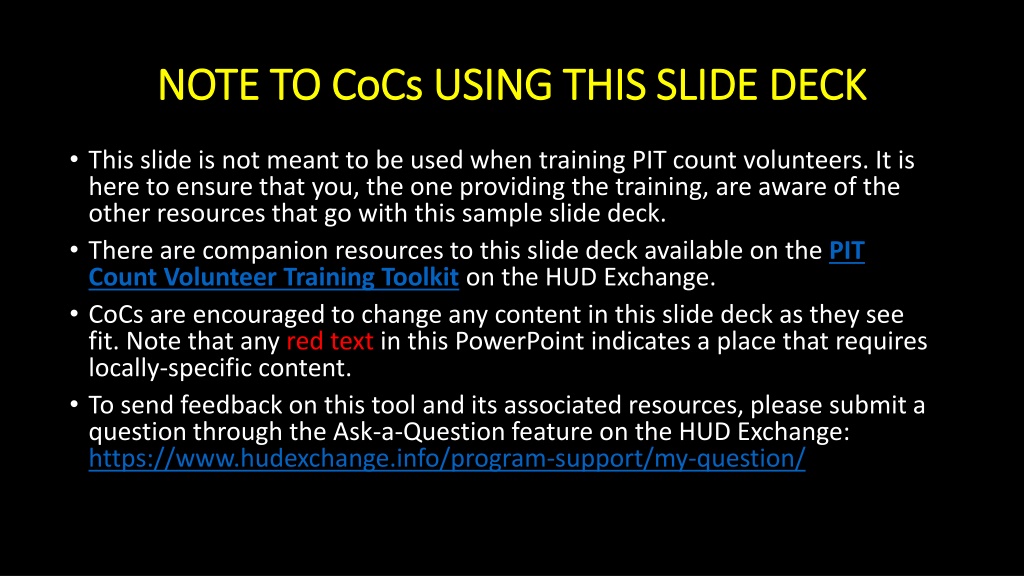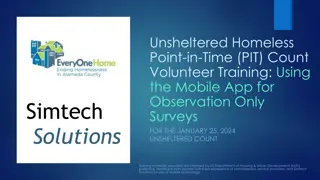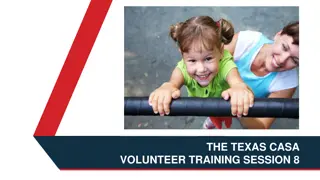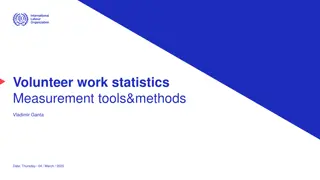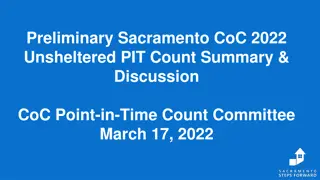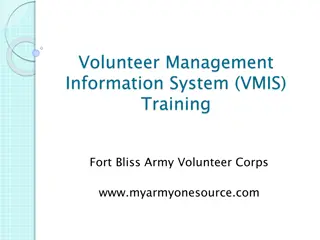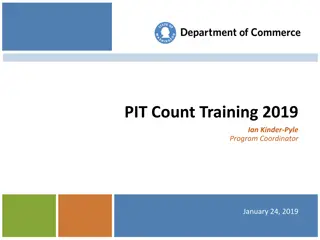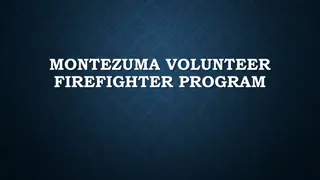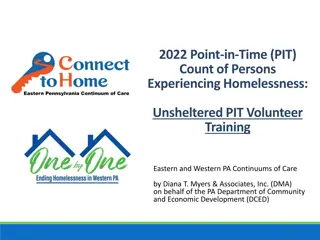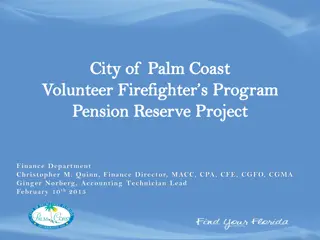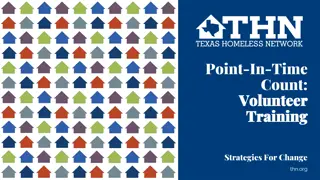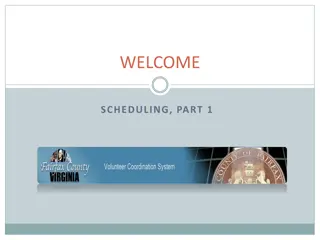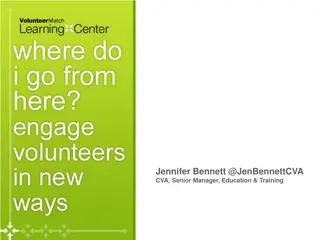Unsheltered Point-in-Time Count Volunteer Training Overview
This slide deck provides guidance for CoCs on conducting effective Unsheltered Point-in-Time (PIT) Counts, highlighting key training agenda topics, volunteer roles, survey practices, and logistic details. It emphasizes the importance of understanding who is counted in the PIT and the purpose of this nationwide initiative to address homelessness.
Download Presentation

Please find below an Image/Link to download the presentation.
The content on the website is provided AS IS for your information and personal use only. It may not be sold, licensed, or shared on other websites without obtaining consent from the author. Download presentation by click this link. If you encounter any issues during the download, it is possible that the publisher has removed the file from their server.
E N D
Presentation Transcript
NOTE TO CoCs USING THIS SLIDE DECK NOTE TO CoCs USING THIS SLIDE DECK This slide is not meant to be used when training PIT count volunteers. It is here to ensure that you, the one providing the training, are aware of the other resources that go with this sample slide deck. There are companion resources to this slide deck available on the PIT PIT Count Volunteer Training Toolkit PIT Count Volunteer Training Toolkit Count Volunteer Training Toolkit on the HUD Exchange. CoCs are encouraged to change any content in this slide deck as they see fit. Note that any red text in this PowerPoint indicates a place that requires locally-specific content. To send feedback on this tool and its associated resources, please submit a question through the Ask-a-Question feature on the HUD Exchange: https://www.hudexchange.info/program-support/my-question/ https://www.hudexchange.info/program-support/my-question/
Unsheltered Point-in-Time (PIT) Count Volunteer Training
PIT Count Volunteer Training Agenda PIT Count 101 PIT Count: What, Who, and Why? FAQs Introduction to surveys & interviews Where to go & who to interview Safety Your Role Survey Practice Tips on surveying Group practice Logistics What to bring, schedule of events, etc. Q&A: What questions do you have?
PIT Count 101 Your Role Survey Practice PIT Count 101 What is the PIT Count? Who is counted in the PIT Count? Why do we do a PIT Count? Other FAQs Logistics
PIT Count 101 What is the Point-in-Time (PIT) count? A literal count of all the people experiencing homelessness in our community on a single night (i.e., at a point in time) Conducted by every community nationwide in the last 10 days of January at least every other year A snapshot of homelessness on this one night in our community
PIT Count 101 Who is counted in the PIT count? The U.S. Department of Housing and Urban Development s (HUD s) definition of homeless, for the purpose of the PIT count, includes two main types of homelessness: Unsheltered: Individuals or families whose primary nighttime residence is a public place not meant for human habitation Sheltered: Individuals or families residing in a place dedicated to serving people who would otherwise be unsheltered
PIT Count 101 Who is counted in the PIT count? Sheltered PIT Count Unsheltered PIT Count Car Park Abandoned building Bus or train station Airport Camping ground Parking Lot Emergency shelters (including those using hotel and motel vouchers) Transitional housing Safe Havens
PIT Count 101 Today s focus: Unsheltered PIT Count Sheltered PIT Count Unsheltered PIT Count Car Park Abandoned building Bus or train station Airport Camping ground Parking Lot Emergency shelters (including those using hotel and motel vouchers) Transitional housing Safe Havens
PIT Count 101 Why do we do a PIT count? To measure and monitor trends and changes in homelessness on local and national levels To help our community understand what resources we need and strategize the best ways to use them to end homelessness To comply with federal regulations and requirements
PIT Count 101 FAQ: Why does the PIT count take place during the last 10 days in January? Same timeframe for every community ensures consistency across the U.S. Same timeframe year after year ensures that trends are monitored appropriately Set for a night in winter because then each CoC is likely maximizing its resources to serve people's needs. Thus, this timing can provide a more precise picture of who is unable to access emergency shelter or other crisis response assistance. End of the month to ensure that people who can only pay for temporary housing for part of the month are generally included in the count. For example, some people can afford to stay in a motel, but only for the first few weeks after receiving their public benefits payment at the beginning of the month
PIT Count 101 FAQ: Why do we have to do the PIT count at night? The PIT count is a count of where people are sleeping on the night designated for the count. If we sent volunteers out before nighttime, we would not get the most accurate data for a few reasons. There may be people who will sleep in unsheltered locations who are not yet out for the night. We want to capture people s actual sleeping arrangement, not where they plan to sleep at a future time. We don t want to only interview people who look the way many people assume those experiencing homelessness must look, which is hard to do during daylight hours.
PIT Count 101 FAQ: How do we conduct an unsheltered PIT count? Brief interviews with people who might be experiencing homelessness using a survey form Observation form if a survey or interview is not possible We ll get to the specifics of what information is collected and how to have conversations to collect it in the next few sections
PIT Count 101 Your Role Survey Practice Your Role in the PIT Count Survey form introduction & how-to Logistics Where to go Who to survey or count
Your Role Survey Form Introduction 3 Possible Forms: General Survey Form Youth Survey Addendum Form Observation Form For use in addition to the general survey form for individual people under 25, or for households headed by someone under 25, who are willing and able to answer your survey questions. For all people or households who are willing and able to answer your survey questions. For any people or households who are unwilling or unable to answer your survey questions.
Your Role Surveying Quick Tips Remember that you are speaking to highly vulnerable people and asking some very sensitive questions. Always lead with respect for the person you re speaking with and respect for their dignity. Everyone has the right to refuse to answer any or all of your questions. Ask all questions, unless the person has already given the answer to the question over the course of your conversation. Always ask questions as they are written; do not ask questions in a way that shows you think you already know the answer. Example: Ask: How do you identify your gender? Do not ask: You re male, right?
Your Role Form #1: General PIT Count Survey Form Always start with this form (we ll talk about special considerations for folks who don t want to or can t complete the survey with you for some reason) Complete one survey form per household
Your Role Form #2: Youth Survey Form Use with anyone under 25 who is not accompanied by a parent. Start with the general survey form, then turn to this one AFTER you ve asked the general survey form questions.
Your Role Step-by-Step Guide to Conducting Interviews Step 1: Approach & Introduction Approach the person and introduce yourself Ask if the person has a few minutes to answer some questions Keep in mind: Individuals sleeping outside may be dealing with active addiction, mental health concerns, and significant trauma histories. Do not sneak up on or startle people. Never shine flashlights in people s faces. Maintain eye contact (if possible) and an open stance with your hands visible. Use a tone of voice that s approachable. Speak slowly, be polite, and don t shout. Hi, my name is [name]. We re out here trying to talk to folks who might not have a safe place to sleep tonight. Do you have a safe place to sleep tonight? Do you know where I might find some people around here who don t?
Your Role Step-by-Step Guide to Conducting Interviews Step 2: Explain what you re doing & get consent Explain why you re there Explain to volunteers how you want them to handle any incentives you re offering If they consent to answering your questions, continue with the interview. If they don t, thank them for their time, and use the observation form. We re conducting a survey, and your participation will help the community provide better services and resources for people who might not have a safe home to sleep at night. It ll take about 4-5 minutes, you don t have to answer any questions you don t want to answer, and it s all anonymous meaning your name won t be used. Are you willing to answer these questions?
Your Role Step-by-Step Guide to Conducting Interviews Step 3: Conduct the interview using the survey form Go through each question in the survey form. Remember: people have the right not to answer all questions! Add any notes that may be helpful Example: If a person says that they have their own apartment, but they re sitting on a bench outside of a 24-hour grocery store at 2:00 am with what appear to be all of their belongings, write down that you think there may be a discrepancy in what they are saying vs. where they will sleep that night.
Your Role Step-by-Step Guide to Conducting Interviews Step 4: Closing the interview Thank the person for their time Refer them to any services or resources they may have asked about or may need. Offer everyone a resource sheet / contact card Give them the incentive
Your Role Step-by-Step Guide to Conducting Interviews Step 5: Recording what you heard and observed Walk away from the person interviewed to a safe place Take a few minutes after your conversation to double check that you ve completed the whole survey form Include any additional notes or details Make sure everything you have written is readable
Your Role Form #3: Observation Form Only use when unable to complete a survey with someone. Include as much detail as possible that helps to make the person identifiable and to provide clues on their housing status.
Your Role Step-by-Step Guide to Observations Step 1: Approach, Introduction & Consent Follow the same protocol you used with the interviews, and only use the observation form if the person says they don t want to answer your questions, or if they can t for some reason (e.g., if they re sleeping).
Your Role Step-by-Step Guide to Observations Step 2: Fill out the Observation Form Write down as much detail as possible that helps to make the person identifiable and to provide clues on their housing status. What is the person wearing? (e.g., Yankees baseball cap, navy GAP sweatshirt, jeans, and tan utility boots. or bundled in a grey, puffy sleeping bag that covered their face. ) What does the person look like? (e.g., shoulder-length grey hair, white, female, 50- 60 years old ) Whywere you unable to complete a survey with them? (e.g., They said they did not want to complete a survey, but they were awake. ) Where did you see them? (e.g., On 20th St. NW between R St. and S St., sitting on the bench outside of X store. ) What makes you think that they are or may be experiencing homelessness? (e.g., They were sleeping on a park bench with a large bag of their belongings next to them. )
Your Role Where to Go during the PIT Count Sample Map: Hotspot Hotspot or Known Locations Known Locations Methodology
Your Role Where to Go during the PIT Count Sample Map: Complete Coverage Complete Coverage or Full Census of Random Sample of Areas Sample of Areas Methodology Full Census of Random
Your Role Where to Go Outdoor public places: Parks Public benches Bus stops Doorsteps of businesses that are closed for the night Encampments Parked cars Indoor places: 24-hour businesses (e.g., grocery stores, McDonald s, Wal-Mart, convenience shops) Bus, train, & metro stations Ask folks who you see out and about if there is anywhere else you should go Employees at businesses that are open Law enforcement (e.g., sheriffs and local police) Others you interview
Your Role Who to Interview It is not always possible to determine if someone is experiencing homelessness based solely on how they look. Consider: Where do you see the person? What is the person doing? What time is it?
Your Role Who to Interview Pitfall: Making assumptions about who to interview using stereotypes of what homelessness looks like. Best practice: Approach everyone you see. You can use a soft, non- confrontational introduction that s easy to reverse course if the person is not experiencing homelessness. Hi, my name is [name]. We re out here trying to talk to folks who might not have a safe place to sleep tonight. Do you have a safe place to sleep tonight? Do you know where I might find some people around here who don t?
Your Role Should I wake someone who is sleeping? [IF YES] Yes, but follow these practices: Do not touch them. Use your voice to wake them. Speak slowly and calmly. Remember that they may be disoriented or irritated when waking up. As with all other people interviewed, do not force them to answer your questions if they say they do not want to or refuse to speak with you. Thank them for their time, apologize for waking them, and complete an observation-based form. [IF NO] No. Use the observation-based form to fill out as much information about the person as you can observe. [Regardless of your CoC s policy on waking people] If someone appears to be sleeping in a dangerous situation, follow your CoC s emergency protocol to alert the appropriate people. Do not wake them on your own.
Your Role Your Safety You should ALWAYS be with at least one other person. Keep an appropriate conversational distance from those you are interviewing. Maintain awareness of the space around you where other people are, ways to get in or out of the space you re in, etc. Remain standing. It s okay to squat down to speak with someone who is sitting or lying on the ground, but always maintain your balance. Stay in places that are lit, including alleyways. If you use a flashlight, do so respectfully (i.e., don t shine it in anyone s face). Prioritize your own safety. If you don t feel safe approaching someone or going somewhere, don t go. Do not transport anyone other than volunteers in your personal vehicle Locally-specific instructions for who to call in case of emergency Locally-specific precautions (examples in trainer s guide)
Your Role Safety of Those you Interview Health & safety concerns (especially if it s cold outside) Notice if: They have layers under and on them to keep them warm enough They re dry (hypothermia concerns) You can see the rise and fall of their breathing Add your local protocol for what to do in your community if an individual is in distress, seeking immediate shelter, needs more layers, etc. ALWAYS call 9-1-1- if you are or someone else is at risk of danger
PIT Count 101 Your Role PIT Count Surveying & Interviewing Practice Dos and don ts Survey Practice Logistics Practice going through the survey form interview with partners and groups
Survey Practice Surveying Quick Tips Remember that you are speaking to highly vulnerable people and asking some very sensitive questions. Always lead with respect for the person you re speaking with and their dignity. Everyone has the right to refuse to answer any or all of your questions. We ll talk later about how to record information about anyone who refuses to answer any or all questions. Ask all questions, unless the person has already volunteered the answer to the question over the course of your conversation. Always ask questions as they are written; do not embed assumptions into how you ask, even if you think you already know the answer. Example: Ask: How do you identify your gender? Do not ask: You re male, right?
Survey Practice PIT Count Dos DO get consent before asking PIT count survey questions DO remember that you may be entering into someone s personal or private space DO have a conversation with the people you interview DO respect people s time
Survey Practice PIT Count Don ts DON T take personal photos of or with the people you survey DON T ask questions in a way that assumes you know the answer DON T insert yourself into the person s story DON T force people to answer questions they don t want to answer DON T make promises you can t deliver
Survey Practice Any tips from volunteers who have participated the PIT count before? Share your thoughts and experiences! What surprised you? What did you learn? What do you wish you had known before going out to survey people?
Survey Practice Survey Practice Split up into partners, and practice: Introducing yourself Asking for the person s consent to participate in the interview Walking through the survey questions
Survey Practice Survey Practice Reflections How did it go? What did you say to introduce yourself that seemed to work for you? What was easy or felt comfortable? What was challenging? What made you uncomfortable? What did you learn that you ll apply when you go out do conduct the PIT count?
PIT Count 101 Your Role Survey Practice Logistics Night-of schedule Logistics What to bring Q&A: What questions do you have?
Logistics Schedule on the Night of the Count [SAMPLE SCHEDULE OF EVENTS on MM/DD/20XX] 8:30-9pm: Arrive at [meeting location] 9-9:30pm: Welcome and overview of the night 9:30-10pm: Meet with your team to exchange phone numbers, set a plan for who will go where and when, and get to know each other 10pm-2am: PIT count 2am: meet your team lead at designated spot to return PIT count survey forms
Logistics Key Contacts Team members: Exchange cell phone numbers with others on your team in case you get lost or split into pairs and need to contact each other PIT count coordinator/lead agency Other local resources or contacts
Logistics Your PIT Count Team This is a placeholder slide for CoCs to insert any relevant information about how and when volunteer teams are decided and any specified roles within those teams.
What to bring CoC will provide: You should bring: Paper survey forms (if applicable) Your vehicle if you volunteered to drive Tablet for mobile surveys (if applicable) Weather-appropriate clothing: Warm, dry clothing that is comfortable to move around in; layers (if it s cold) Don t over-dress (walking around for several hours will generate body heat) Light or bright colored / reflective clothing Shoes: warm, sturdy, comfortable for walking, waterproof if possible Felt-tipped pens (allow you to write in the cold) Flashlights and/or headlamp Clipboard Snacks before departure Small backpack to carry census items and more clothing layers Pack light should be light and easy to carry, despite possible icy sidewalks / other rough terrain. Cell phone (fully charged); remote charger or backup battery. Consider setting an emergency contact (ICE) Some form of ID Eat before you come; bring small snacks if you think it necessary Plan for how you will get home (especially in urban areas with public transit that might shut down before the PIT count is over) Energy and compassion; a good set of eyes (visual observation is key)
Q&A What questions do you have?
Additional Opportunities to Get Involved Annual PIT Count Planning Process & Opportunities Additional Volunteer Activities
Additional Resources For more information about how the information collected during PIT counts is used and reported, visit the HUD Exchange webpage: All Annual Homeless Assessment Reports (AHARs) For information about how PIT count methodologies are standardized nationwide, review the PIT Count Methodology Guide Local organizations doing similar work / opportunities to volunteer
